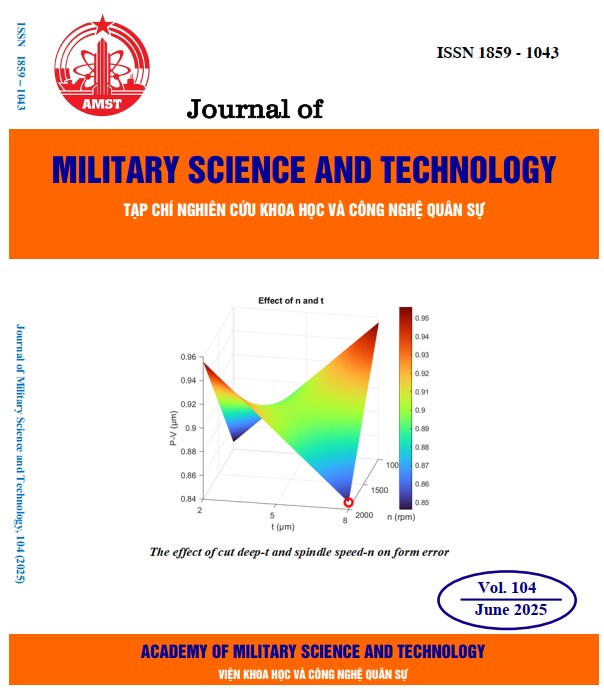Research on the influence of cutting parameters and optimization of spherical surface form error in ultra-precision turning using Box-Behnken and Genetic Algorithm
358 viewsDOI:
https://doi.org/10.54939/1859-1043.j.mst.104.2025.192-200Keywords:
SPDT; Lens; Spherical; Form error; Genetic algorithm.Abstract
Ultra-precision diamond turning is a crucial method in manufacturing optical components and precision mechanical parts, especially for machining spherical surfaces. However, the form error of the machined surface is influenced by various factors such as spindle speed, depth of cut and feed rate. This study analyzes the effects of cutting parameters on form error when machining spherical surfaces on an ultra-precision lathe. Fifteen experiments were conducted with machining parameters, including spindle speed, feed rate, and depth of cut, within the recommended range of the lathe. A form error model was developed based on the Box-Behnken model to simulate and evaluate the accuracy of the machined surface. Experimental analysis shows that all machining parameters significantly affect form error. Increasing or decreasing both spindle speed and depth of cut reduces form error, while increasing feed rate generally leads to higher form error. The Genetic Algorithm (GA) was applied to optimize cutting parameters, achieving a minimum form error of 0.846 µm with an optimal spindle speed of 2000 rpm, feed rate of 5 µm/min, and depth of cut of 8 µm. This study develops a predictive model for form error in diamond turning of spherical surfaces and optimizes cutting parameters. It also improves understanding of how machining parameters affect form error, aiding process prediction and optimization for better machining quality in single-point diamond turning (SPDT).
References
[1]. Yuqi Dai et al., “Forced-based tool deviation induced form error identification in single-point dia-mond turning of optical spherical surfaces,” Precision Engineering, Vol. 72, pp. 83-94, (2021). DOI: https://doi.org/10.1016/j.precisioneng.2021.04.001
[2]. M. Tauhiduzzaman et al., “Form error in diamond turning,” Precision Engineering, Vol. 42, pp. 22-36, (2015). DOI: https://doi.org/10.1016/j.precisioneng.2015.03.006
[3]. Benny C. F. Cheung et al., “Editorial for the Special Issue on Advances in Ultra-Precision,” Mi-cromachines, Vol. 13, p. 2093, (2022). DOI: https://doi.org/10.3390/mi13122093
[4]. Julong YUAN et al., “Review on the progress of ultra-precision machining technologies,” Frontiers of Mechanical Engineering, Vol. 12, No. 2, pp. 158-180, (2017). DOI: https://doi.org/10.1007/s11465-017-0455-9
[5]. Vinod Mishraa et al., “Development of Aspheric Lenslet Array by Slow Tool Servo,” Materials To-day: Proceedings, Vol. 24, pp. 1602-1607, (2020). DOI: https://doi.org/10.1016/j.matpr.2020.04.481
[6]. Xiaonan Pu et al., “Fast tool servo-based ultra-precision diamond sculpturing for fabricating mi-cro-structured surfaces,” International Journal of Mechanical Sciences, Vol. 263, p. 108790, (2024). DOI: https://doi.org/10.1016/j.ijmecsci.2023.108790
[7]. Y. Huang et al., “Improving the performance of single point diamond turning surface with ion beam figuring,” Optik, Vol. 172, pp. 540-544, (2018). DOI: https://doi.org/10.1016/j.ijleo.2018.07.039
[8]. Chengsong Shu et al., “Fabrication of curved aspheric compound eye microlens array with high surface quality by precision glass molding,” Precision Engineering, Vol. 82, pp. 129-139, (2023). DOI: https://doi.org/10.1016/j.precisioneng.2023.03.009
[9]. Yung-Tien Liu et al., “An investigation into the aspheric ultraprecision machining using the re-sponse surface methodology,” Precision Engineering, Vol. 44, pp. 203-210, (2016). DOI: https://doi.org/10.1016/j.precisioneng.2015.12.006
[10]. C.L. He et al., “Characteristics of cutting force and surface finish in diamond turning of polycrys-talline copper achieved by friction stir processing (FSP),” Journal of Materials Processing Technol-ogy, Vol. 301, p. 117451, (2022). DOI: https://doi.org/10.1016/j.jmatprotec.2021.117451
[11]. Yi-Tung Kao et al., “A hybrid genetic algorithm and particle swarm optimization for multimodal functions,” Applied Soft Computing, Vol. 8, pp. 849-857, (2008). DOI: https://doi.org/10.1016/j.asoc.2007.07.002
[12]. Norfadzlan Yusup et al., “Evolutionary techniques in optimizing machining parameters: Review and recent applications (2007–2011),” Expert Systems with Applications, Vol. 39, pp. 9099-9027, (2012). DOI: https://doi.org/10.1016/j.eswa.2012.02.109
[13]. Qinghong Xue et al., “Genetic algorithm-based error correction algorithm for CNC turning machin-ing of mechanical parts,” Journal of Measurements in Engineering, Vol. 11, pp. 509-524, (2023). DOI: https://doi.org/10.21595/jme.2023.23501
[14]. V. Panwar et al., “Experimental investigations and optimization of surface roughness in turning of en 36 alloy steel using response surface methodology and genetic algorithm,” Materials Today: Pro-ceedings, Vol. 46, pp. 6474-6481, (2021). DOI: https://doi.org/10.1016/j.matpr.2021.03.642
[15]. Tingting Chen et al., “Research on the Surface Roughness Predictive Model of Austempered Ductile Iron Based on Genetic Algorithm,” Advanced Materials Research, Vol. 497, pp. 61-67, (2012). DOI: https://doi.org/10.4028/www.scientific.net/AMR.497.61
[16]. Harsita Kedia et al., “Optimization of process parameters in machining of Inconel 718 super alloy on HMT (NH22) capstan lathe using genetic algorithm subject to minimization of surface rough-ness,” Materials Today: Proceedings, Vol. 66, pp. 3910-3915, (2022). DOI: https://doi.org/10.1016/j.matpr.2022.06.390
[17]. Amith Gadagi et al., “A constrained multi-objective optimization of turning process parameters by genetic algorithm and particle swarm optimization techniques,” Materials Today: Proceedings, Vol. 42, pp. 1207-1212, (2021). DOI: https://doi.org/10.1016/j.matpr.2020.12.692
[18]. D. C. Montgomery, “Design and Analysis of Experiments”, John Wiley & Sons, (2006).







